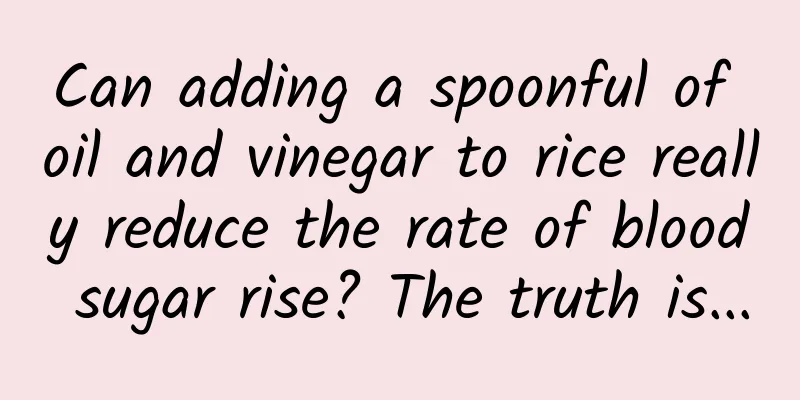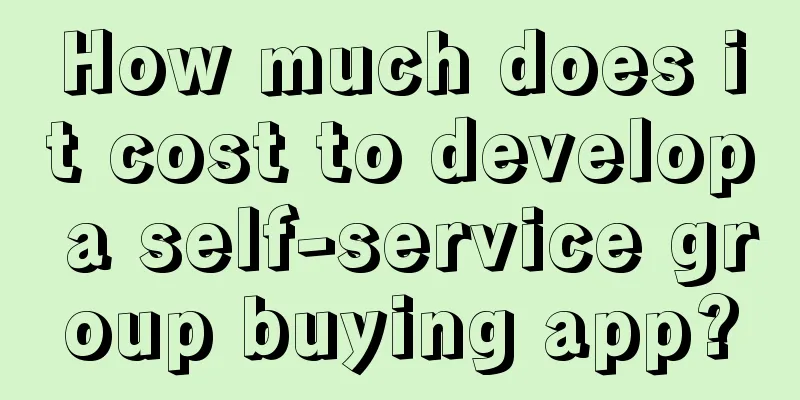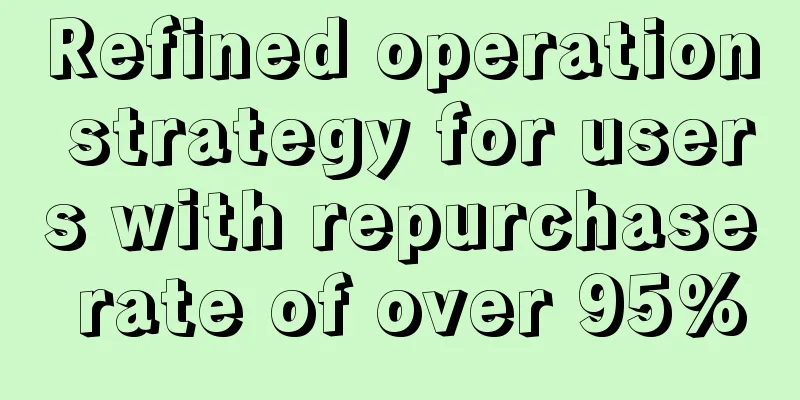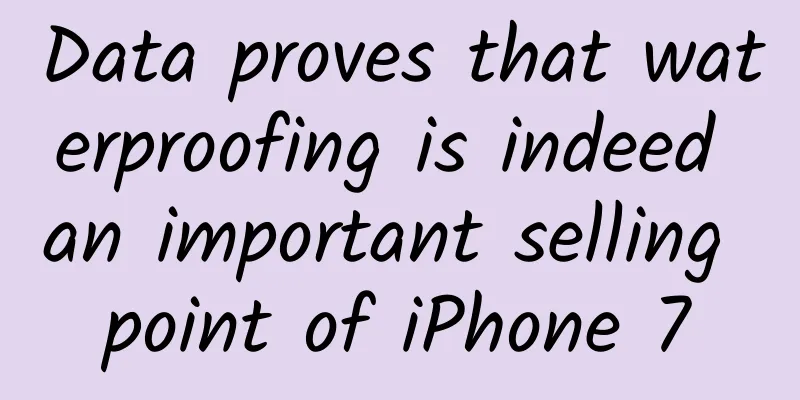Can adding a spoonful of oil and vinegar to rice really reduce the rate of blood sugar rise? The truth is...

|
Recently, several acquaintances have asked me: What I fear most when eating rice is the rise in blood sugar. I saw on the Internet that adding some oil and vinegar when cooking rice can not only make the rice brighter, more fragrant and more delicious, but also reduce the rate of blood sugar rise in rice, so that you won’t gain weight after eating it! Tell us quickly, is there such a magical thing? I replied: Taste is one thing, and blood sugar increase is another. Let me explain them separately. First of all, it’s true that adding some oil and vinegar when cooking rice can make the rice brighter and more fragrant. It is common sense that adding a little oil to any food will improve its appearance and glossiness. The aroma components in food are all fat-soluble. So adding fat can make the aroma components better extracted from the inside of the food. If you add oil that already has aroma, such as sesame oil, walnut oil, and butter, the aroma effect will be even more outstanding. At the same time, fat and the long branches of amylose or amylopectin can form a fat-starch complex . This complex can prevent the aging of starch and keep the rice in a dry and hard state for a long time. In short, adding oil will make rice taste better, which is absolutely true. This is also one of the reasons why people love fried rice. The effect of adding vinegar is more obvious in the northern region . Because the northern region has a lot of hard water, which is weakly alkaline, the main reason for its "hardness" is usually too much calcium ions in the water. Calcium ions interact with starch molecules, pulling the long starch chains together and making them difficult to disperse, making the rice taste harder. After adding a small amount of acid, calcium ions reduce the interaction with starch molecules under acidic conditions, making the rice softer and more delicious. However, as long as the acidity is not too high, the rice grains will not become too soft and will still remain elastic. Hard water also reacts with cellulose, so if you wash towels with hard water, they will become harder. Switching to soft water or adding some white vinegar when washing towels can improve this problem. Both cellulose and starch are polymers of glucose, and they will become hard after being treated with hard water and soften after adding vinegar. The principle is similar. After adding a small amount of acid, calcium ions reduce the interaction with starch molecules under acidic conditions, making the rice softer and more delicious. However, as long as the acidity is not too high, the rice grains will not become soft and will still remain elastic . At the same time, adding vinegar is also helpful to protect the vitamin B1 in rice. Vitamin B1 likes acid and fears alkali by nature, because there is a methylene bridge on its molecule, which is particularly susceptible to nucleophilic attack. Although the vitamin B1 content of white rice itself is very low, it still has some. If it is heated under alkaline conditions, it will continue to lose. Many people like to add alkali to cook porridge, although the porridge is easy to cook, but it is a cruel blow to vitamin B1. In addition to vitamin B1, vitamin B2 is also very afraid of alkali. Therefore, in the alkaline water conditions in the north, adding a small amount of vinegar to cook rice is a measure to protect nutrients . Now let's talk about whether adding oil and vinegar can reduce the blood sugar response after a meal? Most likely it cannot. Because, if you want to slow down the digestion rate of rice and form a large amount of starch-fat complexes, thereby reducing the blood sugar response, as mentioned online, adding only a small spoonful of oil to a pot of rice is definitely not enough, and more oil is needed to be effective. However, adding a large amount of fat will greatly increase the calories, which is not conducive to preventing obesity. At the same time, if you eat a lot of fat in the previous meal, it will also increase the blood sugar response of the next meal [1]. Adding vinegar can also reduce the blood sugar response after a starchy meal, but a large amount of vinegar must be added. Previous research evidence shows that acetic acid can reduce the activity of salivary amylase, slow the rate of starch decomposition, slow gastric emptying, and improve the utilization of blood sugar by muscle tissue [2]. However, according to previous research evidence, approximately 45 grams of vinegar with an acidity of 6% (such as old vinegar) or 60 grams of vinegar with an acidity of 4.5% must be consumed in one meal to be effective. Moreover, the vinegar must be consumed before the rice, or the rice and vinegar must be consumed together . Eating them later will be ineffective. If 45-60 grams of vinegar is added to 100 grams of rice (a full bowl of rice) when cooking, the taste of the cooked rice may be affected. Moreover, acetic acid is a volatile acid, and a large part of it will be emitted along with the water vapor during the cooking process. On the other hand, if you only add a spoonful of vinegar to a pot of rice as suggested online, the rice will not taste sour at all, and it is impossible for it to effectively lower blood sugar response. Another thing that needs to be considered is that if you use large amounts of vinegar to cook rice for a long time, there is also a potential risk of corrosion to the rice cooker. Therefore, people who really need to control their blood sugar should not think that adding a small spoonful of oil or a small spoonful of vinegar can solve the problem of excessive blood sugar rise after eating white rice. To lower the blood sugar response of rice , there are several options that have been proven to be feasible by human trials: 1. Adding some whole grains , such as oatmeal, to steamed rice can effectively lower the glycemic index of the mixed rice[3]. This effect is also seen in a pressure cooker when the rice is cooked until soft. 2 Eat a bowl of low-fat vegetables first , then other dishes, and finally start eating rice[4]. 3 Drink a glass of milk or soy milk with a small amount of sugar before eating your main meal[5]. 4 Eat rice with sour foods such as kimchi, sour plums, and apples soaked in vinegar[6]. 5 Eat half an apple (about 150 grams) half an hour before meals , and then start eating dishes and rice[7]. Because everyone's digestive ability is different and the reasons for weak blood sugar control are also different, not every method may be suitable. Friends who need to control blood sugar can try and see which method works best for them. References: 1 Collier, G.; O' Dea, K. The effect of coingestion of fat on the glucose, insulin, and gastric-inhibitory polypeptide responses to carbohydrate and protein. American Journal of Clinical Nutrition. 1983, 37, 941-944. 2 Li Shuang, Fan Zhihong. Regulatory effect of vinegar on postprandial blood glucose. Chinese Condiments, 2017, 42(1): 153-156 3 Zhu R, Fan Z, Li G, et al. A comparison between whole grain and pearled oats: acute postprandial glycaemic responses and in vitro carbohydrate digestion in healthy subjects. European Journal of Nutrition. 2020, 59(6), 2345-2355 4 Imai S, Kajiyama S, Kitta K, et al. Eating Vegetables First Regardless of Eating Speed Has a Significant Reducing Effect on Postprandial Blood Glucose and Insulin in Young Healthy Women: Randomized Controlled Cross-Over Study. Nutrients 2023, 15, 1174. 5 Sun L, Tan KWJ, Han CMS, et al. Impact of preloading either dairy or soy milk on postprandial glycemia, insulinemia and gastric emptying in healthy adults. European Journal of Nutrition, 2017, 56:77-87 6 Zhao W, Lu J, Fan Z, et al. Co-ingested Vinegar-soaked or Preload Dried Apple Mitigated Acute Postprandial Glycemia of Rice Meal in Healthy Subjects on Equi-carbohydrate Basis. . Nutrition Research, 2020, 83(11):108-118 7 Lu J, Zhao W, Wang L, et al. Apple preload halved postprandial glycaemic response of rice meal in healthy subjects. Nutrients, 2019, 11: 2912 |
<<: A very stealthy feeling! How can this bird catch fish with an "umbrella"?
>>: Thumbs up! Chinese scientists have figured out the organic carbon content in their own oceans
Recommend
New Year's greetings from the China Association for Science and Technology to scientific and technological workers across the country
New Year Greetings Wan Gang, Chairman of the Chin...
Build a healthy body, Liu Mengyi, three consecutive world champions, "Seven Muscle Group Training Sculpting"
Building a healthy body, Liu Mengyi, three consec...
Mini Program Mall Development Company, how to make a mini program on WeChat?
Unconsciously, it is the "Double 11 Festival...
Frequently asked questions about Meizu App Store promotion and account opening advertising!
1. Meizu advertiser registration issues 1. Under ...
How much fruit should you eat every day? How much vitamin C should you take? Many people don't do this.
Fruit is an important part of a balanced diet, pr...
Practical experience sharing on Xiaohongshu operation and promotion
As of January this year, Xiaohongshu has more tha...
The "big claws" that reveal the secrets of evolution? Come and see the whole process of the "big crab" cutting RNA!
On January 25, 2025, Beijing time, Shen Enzhi'...
Seed users, how to achieve growth from 0 to 1?
I believe that many startup teams have encountere...
What is the difference between canned Wangzai and boxed Wangzai? Nutritionist: There is a big difference, don't buy the wrong one
Wangzai, both adults and children love it. After ...
Baby Safe Medication Guide Upgraded Disease Care Guide
Baby's safe medication guide upgraded version...
Tik Tok short video operation and promotion methods!
How can companies operate and promote short video...
Look! China's most magnificent animal wonders
This is the most magnificent animal wonder in nat...
Metro Beauty's three new private domain strategies
Let’s first look at a set of Metropolis Beauty ’s...
Fun fact: Why don’t herbivores eat meat?
I recently saw an interesting question. A netizen...
The most comprehensive analysis of headline information flow advertising! Delivery tips included!
As the largest information flow platform at prese...









